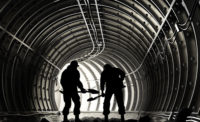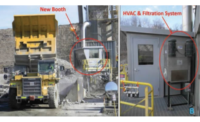From 1986 to 2010, 10 deadly explosions occurred in underground coal mines in the United States. The risk of explosion involves an interrelated chain of events. A source of heat (such as a spark) ignites methane gas in the air of the coal mine tunnel. The sudden pressure created by that blast stirs up deposits of coal dust from mine surfaces. Those combustible particles, now airborne, catch fire too and propagate the explosion with devastating force. Ignition sources, methane, and coal dust all must be controlled to avert risk. Applying large amounts of incombustible limestone dust to mine surfaces, to reduce the risk of airborne coal dust igniting, is one of those control techniques.
To know whether enough limestone dust has been applied to prevent the coal dust from igniting (and whether other controls have been successful in reducing the amount of coal dust in the mine in the first place), you have to analyze a sample of dust to estimate the amount of coal dust in the mix. The challenge: having a reliable method to differentiate between the rock dust and the coal dust in air samples.
Addressing this problem, researchers at the National Institute for Occupational Safety and Health (NIOSH) developed an inventive technique by modifying a tool called the inhalable dust sampler (IOM sampler), created at Scotland’s Institute of Occupational Medicine. NIOSH researchers fitted the IOM sampler with additional parts, including a stainless-steel filter cassette and inlet. In the laboratory, they then evaluated this new tool’s ability to measure airborne coal dust in the presence of rock dust, using samples with known quantities of both types of dust. After obtaining correct measurements in the laboratory, the researchers accurately measured the amount of coal dust in airborne dust samples collected after rock dusting in an underground coal mine. They plan to use this technique in future underground mine studies to test the effectiveness of coal dust controls such as scrubbers and water sprays.
To read the article in the Journal of Occupational and Environmental Hygiene, go to Sampling and Analysis Method for Measuring Airborne Coal Dust Mass in Mixtures with Limestone (Rock) Dust.
To learn more about NIOSH research on coal dust measuring and prevention of coal mine explosions, visit Rock Dusting and Coal Mine Explosion Prevention.



